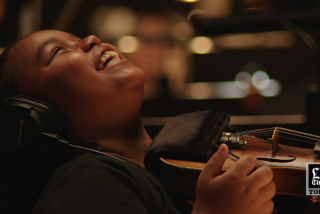Review: Electronic percussion, evolving: Rosenboom, Winant at REDCAT
The REDCAT stage was littered with percussion sets, from snare drums to marimbas, all types of gongs, xylophones and timpani. It looked like a drummer’s candy store.
Saturday night, REDCAT tapped into what it does best with David Rosenboom’s “Zones of Influence.” The composer and CalArts dean wasn’t the evening’s only draw, however. The prolific Bay Area percussionist William Winant stole the show in his own way (It was impossible not to bump into percussionists Saturday night).
“Zones of Influence” is an evening-long work for percussion and electronics, with piano and violin added. Composed in the mid-80s for Winant, the work leans into his strengths as a performer. Saturday’s show also included some geometrically abstract video art by multimedia artist Jinku Kim.
Since the 90 minutes of “Zones of Influence” were played straight through with no intermission, it was natural to break the work up into sections by following Winant as he navigated the various stations, his movement from one set to another the only natural break.
The piece snaps into gear with loud drumming, filtered through synth sounds and some scratchy static. The electronic element was enabled by a new instrument, the Touché II, which Rosenboom designed in collaboration with Martin Zwartjes, an update of a ‘70s model.
Winant dug into the music with grace, his hands tracing the work’s shifty contours. Meanwhile, Rosenboom was at his station behind a piano and several computer screens activating the live electronic responses to Winant’s lithe movements.
After the intense, off-kilter opening, the score slides into a contrasting section based on softly murmuring marimbas. Winant charmed the intimate phrases into existence with a feathery touch while Rosenboom sent out twisted, slithery sounds.
The electronics play a key role, sometimes crackling in the background, sometimes asserting themselves with huge waves of sound. They are also integrated ingeniously with the human performers, as they bounce off key musical themes with algorithmic complexity.
The same mathematical rigor is applied to many parameters of the work. Rosenboom calls these “shapes,” and they describe everything from the melodies used to the relative speed of the music to the digital filters, and even the form itself. The work’s title reflects its self-referential nature. Everything is related to everything else, so that even though it sounds disheveled on the surface, it actually feels unified.
“Zones of Influence” (just out on a new recording from Pogus Productions) ends with a long joyous section, Rosenboom scratching out slides on amplified violin, body swaying like a rock star, while Winant grounded the flamboyant gestures with timpani rolls and sharp hits on metal. The last thing heard is a short synth wave, growing loud then back to soft, a quiet encomium to a big, swaggering work.
More to Read
The biggest entertainment stories
Get our big stories about Hollywood, film, television, music, arts, culture and more right in your inbox as soon as they publish.
You may occasionally receive promotional content from the Los Angeles Times.






